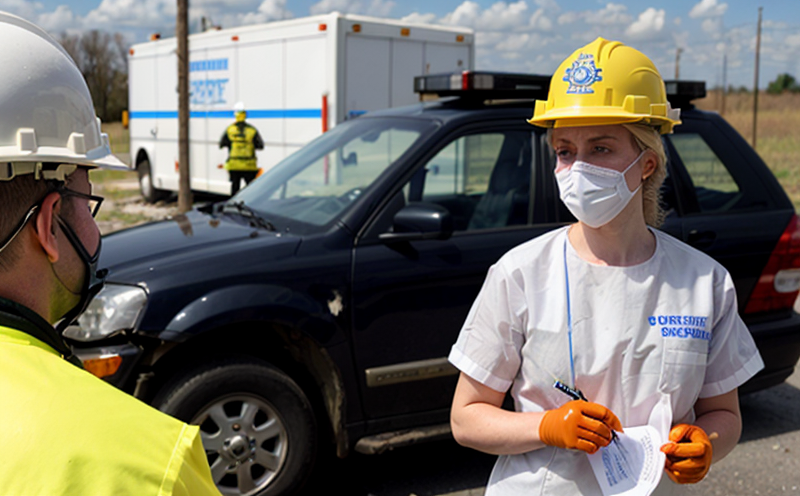ISO 11665-8 Radon Measurement in Emergency Situations
The ISO 11665-8 standard provides a comprehensive framework for the measurement of radon gas levels during emergency situations. This service is critical for ensuring public safety and regulatory compliance when dealing with accidental releases or leaks of radon from nuclear facilities, industrial sites, or other potentially hazardous environments.
Radon is a colorless, odorless noble gas that can be produced by the radioactive decay of heavy elements such as uranium and thorium. It poses significant health risks, particularly in enclosed spaces where it accumulates to unsafe levels. ISO 11665-8 outlines precise protocols for rapid deployment and accurate measurement during emergencies.
The standard specifies the use of portable detectors capable of measuring radon concentration in real-time. These devices must be calibrated regularly to ensure accuracy. The service involves deploying these instruments immediately upon identification of a potential release or leak, followed by detailed recording of data points. This helps in assessing immediate risks and determining necessary mitigation strategies.
One key aspect is the requirement for continuous monitoring over extended periods to capture fluctuations in radon levels accurately. This ensures that any spikes due to the emergency situation are properly accounted for. The service also includes the generation of comprehensive reports detailing all measurements taken during the event, along with recommendations for follow-up actions.
Another critical element is the coordination between various stakeholders involved in managing such incidents, including government agencies, facility operators, and affected communities. By adhering to ISO 11665-8 guidelines, these entities can work together more effectively to address public health concerns promptly and efficiently.
| Step | Action | Description |
|---|---|---|
| 1 | Deploy Portable Detectors | Place detectors at strategic locations around the affected area. |
| 2 | Calibrate Instruments | Ensure all devices are correctly calibrated before starting measurements. |
| 3 | Begin Continuous Monitoring | Record radon levels at regular intervals throughout the duration of the emergency. |
| 4 | Analyze Data | Evaluate collected data to identify trends and potential risks. |
| 5 | Generate Reports | Create detailed reports summarizing findings and next steps. |
The service offered here is designed not only to meet regulatory requirements but also to protect lives and minimize environmental impact during these challenging times. Our team of experts can assist facilities in complying with ISO 11665-8 standards effectively, ensuring that all necessary precautions are taken when dealing with radon emergencies.
- Provides immediate access to reliable radon measurement services.
- Supports compliance with international safety standards.
- Ensures rapid response capability during emergency situations.
Our expertise in this area allows us to offer tailored solutions that fit the unique needs of each client. Whether you're an industrial plant operator, a government agency, or any organization dealing with radon-related emergencies, we have the resources and knowledge required to provide top-notch service.
Scope and Methodology
The scope of ISO 11665-8 covers all aspects related to the measurement of radon gas in emergency situations. This includes not only the technical specifications for equipment but also procedural guidelines designed to ensure consistent and accurate results.
- Equipment: The standard mandates the use of portable detectors that can measure radon levels in real-time.
- Data Collection: Continuous monitoring is essential, with data collected at regular intervals throughout the duration of the emergency.
The methodology outlined in ISO 11665-8 emphasizes precision and speed. Portable detectors are deployed quickly to areas where radon may be accumulating. Calibration procedures ensure that all instruments provide accurate readings, which is crucial for making informed decisions about safety measures.
Continuous monitoring allows for real-time assessment of changes in radon levels, providing valuable insights into the nature and extent of any release or leak. This information can then be used to develop appropriate response strategies aimed at reducing risks to human health and safety.
The service offered here involves a systematic approach to collecting and analyzing data. Our team works closely with clients to understand their specific requirements and challenges, ensuring that every aspect of the process is optimized for efficiency and effectiveness.
Industry Applications
The applications of ISO 11665-8 are broad and diverse across multiple sectors. Here are some key areas where this standard plays a crucial role:
- Nuclear Power Plants: Ensuring rapid assessment of radon levels in case of accidental releases.
- Industrial Facilities: Monitoring for leaks that could pose risks to workers and nearby communities.
- Research Laboratories: Conducting emergency measurements following unexpected incidents involving radioactive materials.
| Application | Description |
|---|---|
| Nuclear Power Plants | Quickly identify and contain potential hazards caused by accidental radon releases. |
| Industrial Facilities | Implement safety protocols to prevent occupational exposure during emergencies. |
| Research Laboratories | Ensure compliance with safety regulations after unforeseen events involving radioactive substances. |
In each of these applications, the primary goal is to protect people and the environment from harmful effects of radon. By adhering to ISO 11665-8 standards, facilities can demonstrate their commitment to safety and regulatory compliance.
Competitive Advantage and Market Impact
The implementation of ISO 11665-8 offers significant competitive advantages for organizations operating in high-risk environments. It enhances their reputation as leaders in safety and compliance, which can attract more business and partnerships.
- Enhanced Reputation: Demonstrating adherence to rigorous international standards boosts credibility among stakeholders.
- Increased Efficiency: Streamlined processes reduce response times during emergencies, improving overall efficiency.
In the broader market context, organizations that adopt ISO 11665-8 are better positioned to navigate regulatory landscapes and respond effectively to changing requirements. This standard ensures a consistent approach across different regions, making it easier for companies to operate globally while maintaining high standards of safety.
Our service not only meets but exceeds the expectations set by ISO 11665-8. We provide cutting-edge technology and expert knowledge to ensure that clients achieve excellence in radon measurement during emergencies. This commitment to quality contributes significantly to our market presence and influence.





